What is Somnath temple (Prabhas Kshetra) history (information) (facts)
Namaste friends, how are you doing today? Welcome to #BhagavanBhakthi website / blog.
Bhagavan Lord Sri Rama (Narayana) (Vishnu) (Krishna) and Lord Shiva blessings to you and your family!
In this website / blog, you will always learn about #Hinduism #Sanskrit language.
Also subscribe to my YouTube channel from this link #BhagavanBhakthi to view videos about #Hinduism #Sanskrit language.
Just before moving towards to know about “What is Somnath temple (Prabhas Kshetra) history (information) (facts)“, let us know few basic and important information.
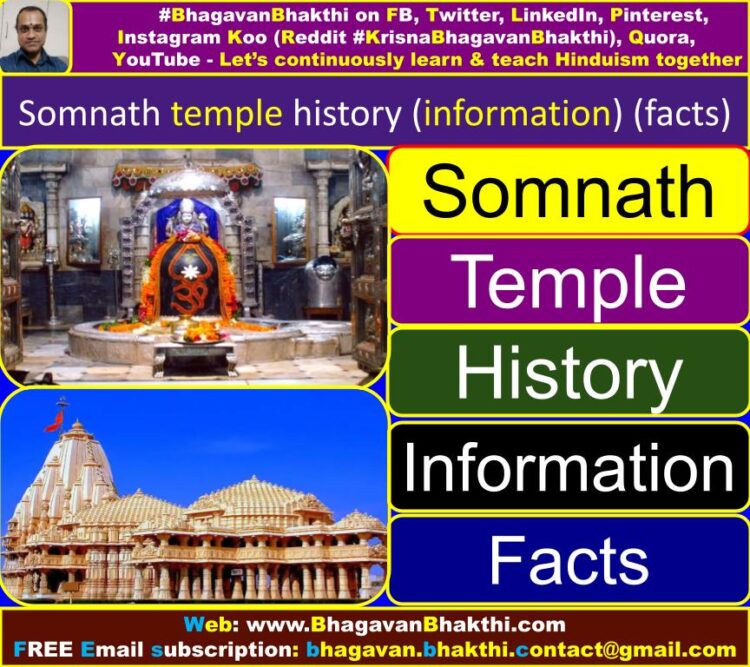
Somnath in Sanskrit is written as Somanatha (सोमनाथ / ಸೋಮನಾಥ / sōmanātha).
In Hindi it is pronounced and written as Somnath (Sōmnāth).
Here Somnath = Som + Nath = Lord Chandra (Moon God) + Ishwar (Lord) = Somnath is someone who is Lord to Lord Chandra (Moon).
Once, while describing the origin of puranas, Sutaji told the sages who had assembled at Naimisharanya:
‘Lord Shiva had first revealed the contents of Skanda Purana to Goddess Sri Parvati Devi at Kailash Mountain.’
‘Lord Sri Brahma Deva and few other Devatas (Demigods) were also present there at the time when Lord Shiva was narrating the tale.’
‘Subsequently, Goddess Sri Parvati Devi narrated this tale to Lord Skanda (Kartikeya),’
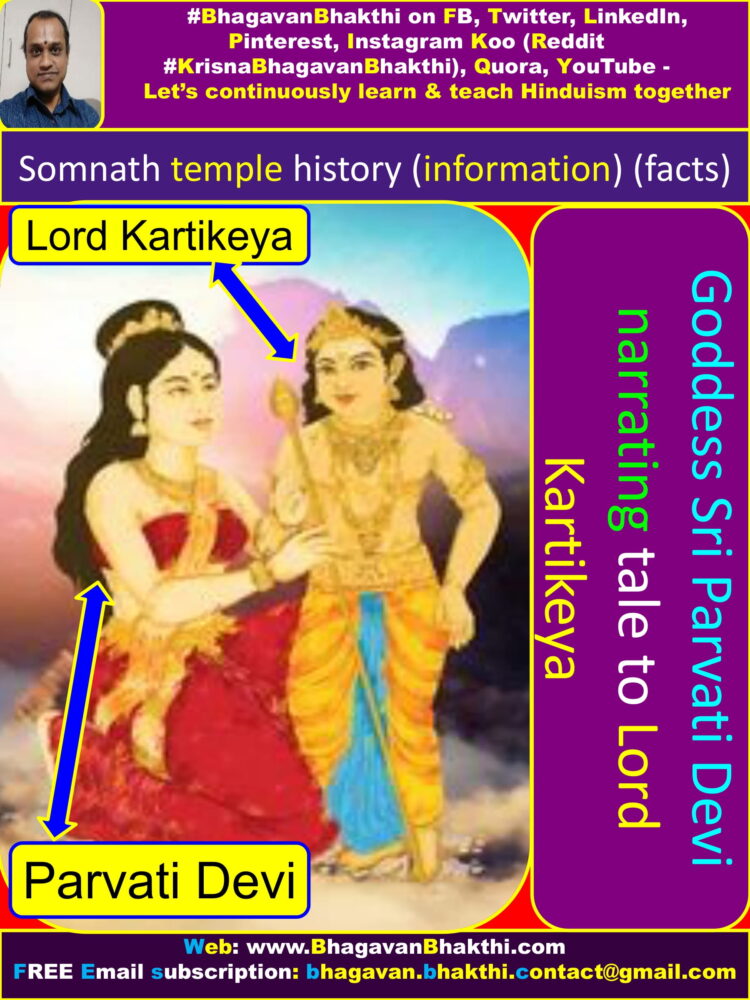
‘then Lord Skanda to Nandi (Lord Shiva mount) and then later,
Nandi to sages like Sanat Kumaras, etc. and finally Sanat Kumaras narrated it to Lord (Sage) Sri Veda Vyasa Ji (He is an avatar of Bhagavan Sri Vishnu).’
‘Now I (Sutaji) am going to tell you the same tale which Lord (Sage) Sri Veda Vyasa Ji had narrated to me.’
List of Somnath temple history (information) (facts) are as given below:
Manifestation of four Vedas
Puranas appeared from Brahma mouth
Purana names
Upa Puranas also appeared
Features of each Purana
Upa Purana origin from main Puranas
Upa Purana names
Purana can be categorized into three main types
Satvika Puranas
Rajasika Puranas
Tamasa Puranas
Satvika Puranas contain the tales of Bhagavan Sri Vishnu
Rajasika Puranas contain the tales of Sri Brahma Deva
Tamasa Puranas contain the tales of Sri Rudra Deva
And so on…
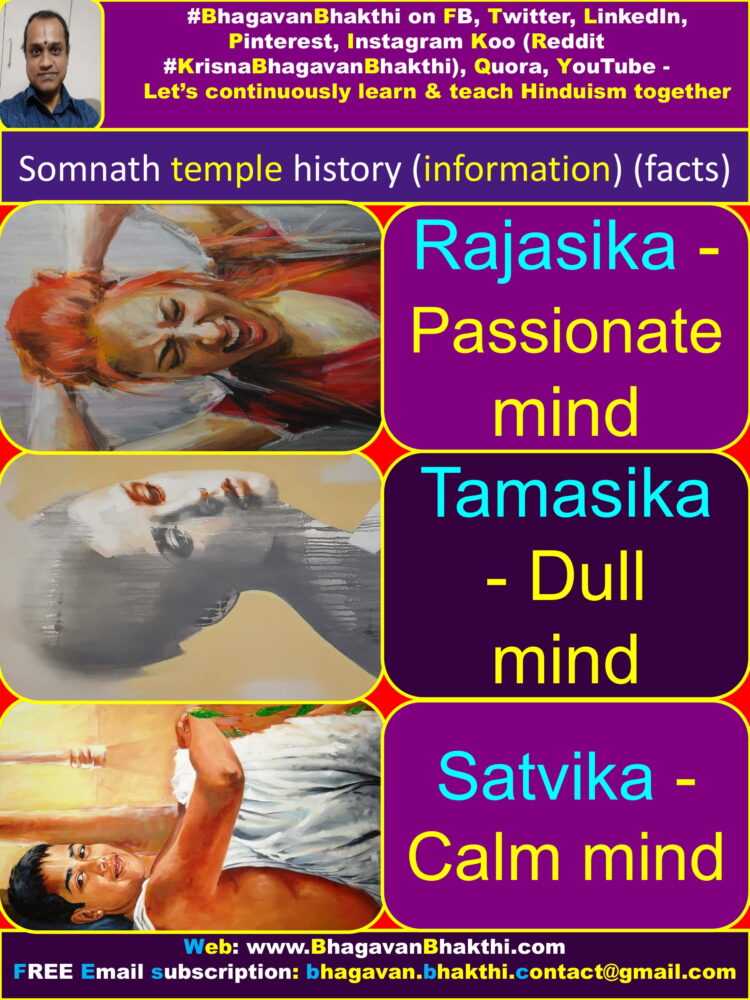
Sutaji began by saying:
‘During ancient times, Sri Brahma Deva once did a very austere penance resulting into the manifestation of all the four Vedas.’
‘Later on, all the eighteen Puranas too appeared from his mouth.
The eighteen Puranas names are as given below:
1. Brahma Purana, 2. Vishnu Purana, 3. Shiva Purana,
4. Bhagavata Purana, 5. Bhavishya Purana, 6. Narada Purana,
7. Markandeya Purana, 8. Agni Purana, 9. Brahma Vaivarta Purana,
10. Linga Purana, 11. Padma Purana, 12. Varaha Purana,
13. Skanda Purana, 14. Vamana Purana, 15. Kurma Purana,
16. Matsya Purana, 17. Garuda Purana and 18. Vayu Purana
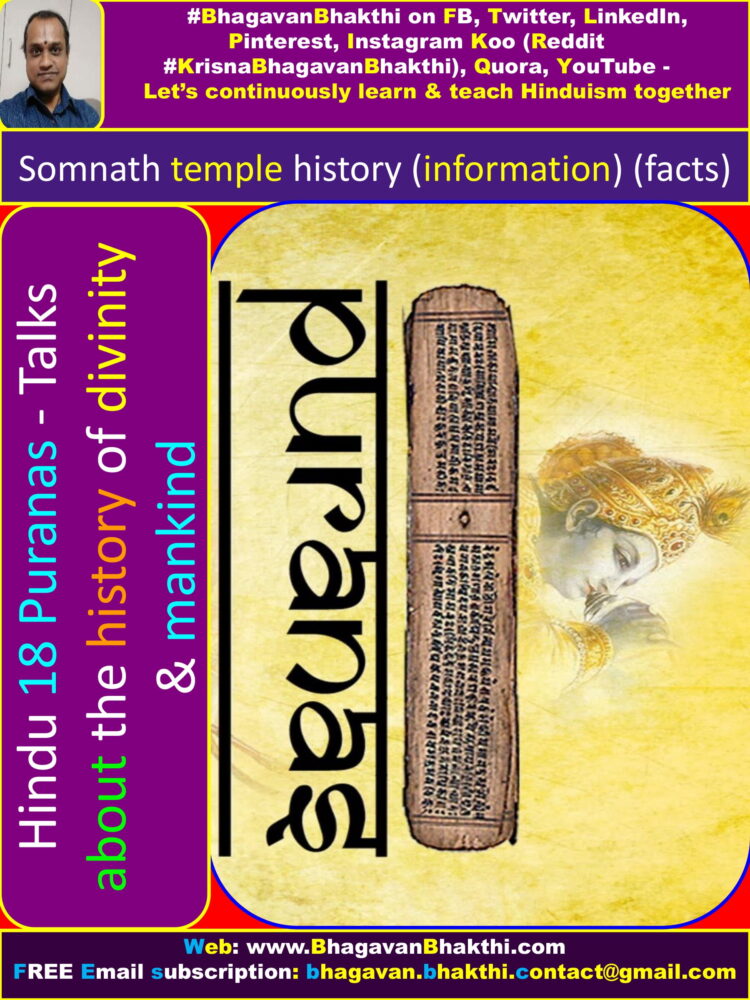
Apart from these eighteen main Puranas, there are also similar number of secondary Puranas known as ‘Upa Puranas‘.
Upa Puranas name are as given below:
1. Sanatakumara, 2. Narasimha, 3. Skanda,
4. Shiva Dharma, 5. Durvasa, 6. Narada,
7. Kapila, 8. Manu, 9. Ushana,
10. Brahmanda, 11. Varuna, 12. Kalika,
13. Maheshwara, 14. Samba, 15. Saura,
16. Parashara, 17. Maricha and 18. Bhargava

Sutaji then went on to describe the other features of each Purana:
Features of each Purana is as given below:
1. Brahma Purana contains ten thousand shlokas in it
2. Padma Purana contains fifty-five thousand shlokas
3. Similarly, there are twenty-three thousand shlokas in Vishnu Purana
4. Vayu Purana contains the tales related with Lord Shiva and it contains twenty-four thousand shlokas in it
5. Bhagavata Purana has 18,000 shlokas
6. Narada Purana has 25,000 shlokas
7. Markandeya Purana has 9,000 shlokas
8. Agni Purana has 16,000 shlokas
9. Bhavishya Purana has 14,500 shlokas
10. Brahma Vaivarta Purana has 18,000 shlokas
11. Linga Purana has 11,000 shlokas
12. Varaha Purana has 24,000 shlokas
13. Skanda Purana has 81,100 shlokas
14. Vamana Purana has 10,000 shlokas
15. Kurma Purana has 17,000 shlokas
16. Matsya Purana has 14,000 shlokas
17. Garuda Purana has 18,000 shlokas
18. Brahmanda Purana has 12,200 shlokas
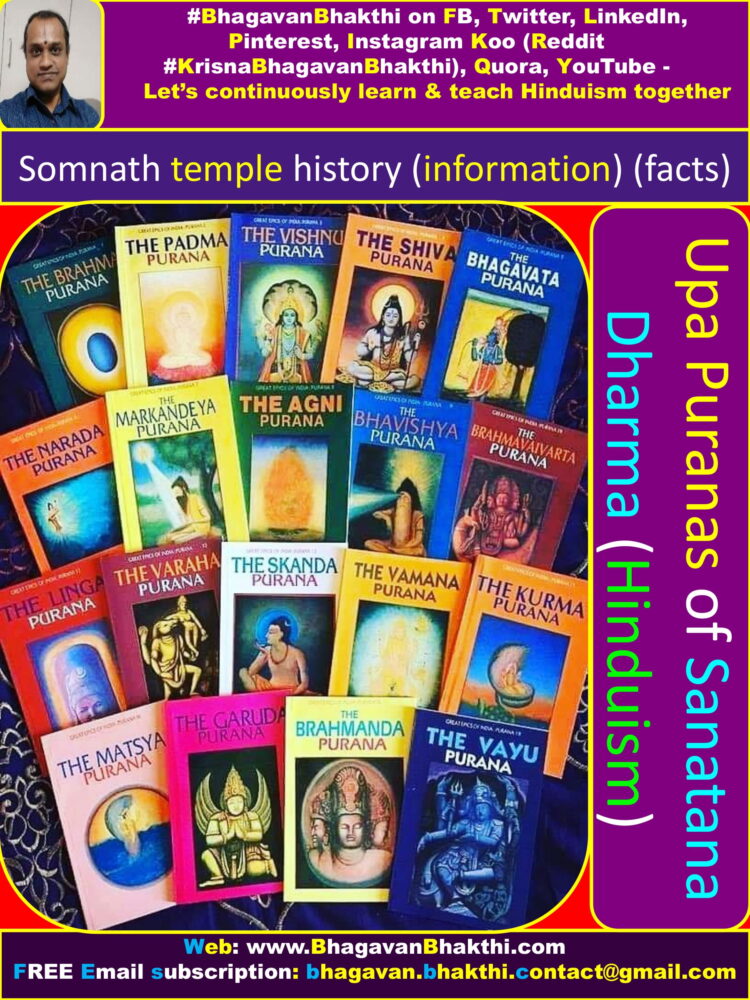
Sutaji told the sages that all the Upa Puranas owe their origin to the main Puranas which are eighteen in number.
Sutaji also revealed to them that Puranas can be categorized into three main types such as:
1. Satvika
2. Rajasika and
3. Tamasa
4. Satvika Puranas contain the tales of Lord Sri Vishnu
5. Rajasika Puranas contain the tales of Lord Sri Brahma Deva
6. Tamasa Puranas contain the tales of Lord Sri Rudra Deva (Shiva)
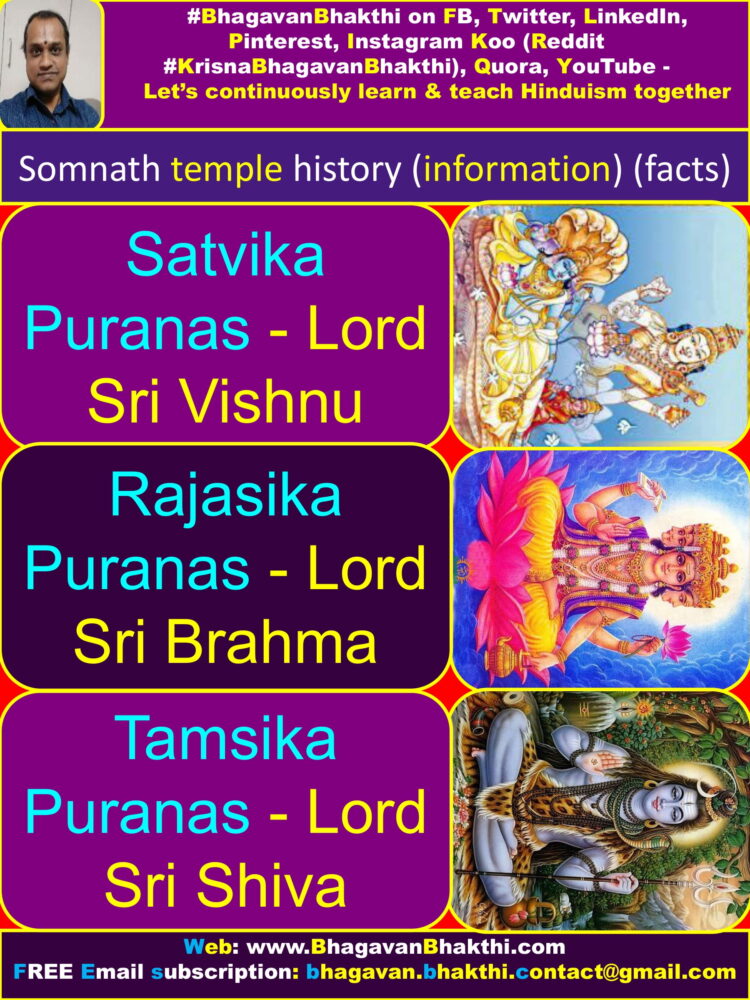
One of the chief characteristics of Puranas is that each of them is divided into five sections, that is:
1. ‘Sarga’ (Description of how creation began)
2. ‘Pratisarga’,
3. ‘Vansh (Vamsha)’ (Description of prominent dynasties)
4. ‘Manvantara’
6. ‘Vanshanu Charita’ (Vamshanu Charita) (Tales related with the descendants of the famous sages).
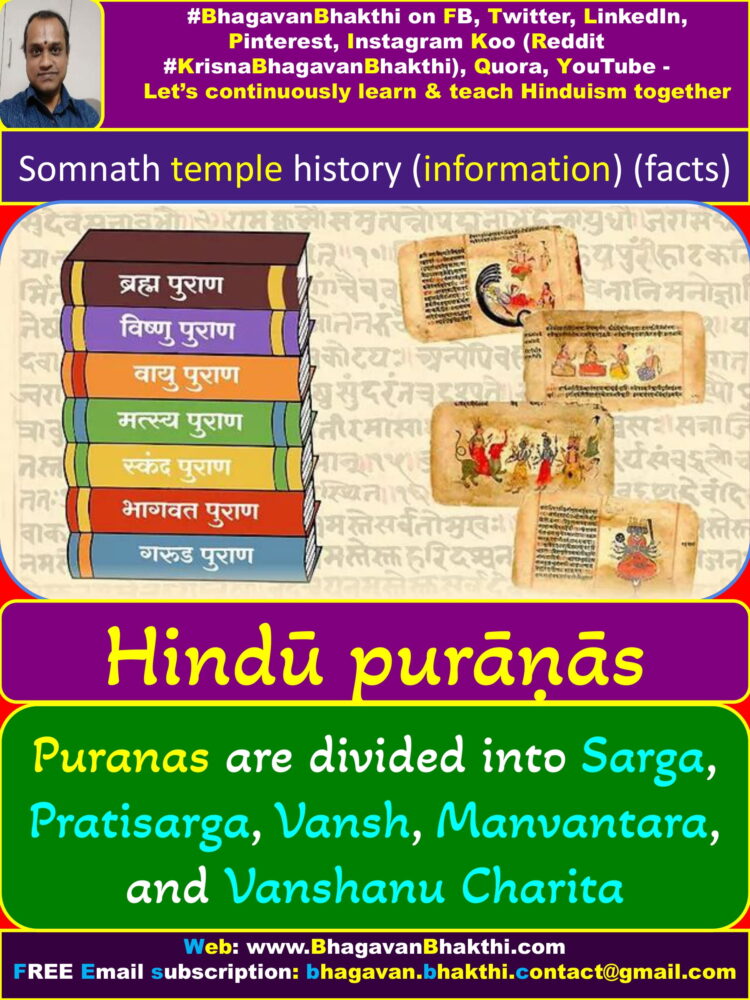
About Prabhas (Prabhas) Tirtha
On being asked by the sages about the prominent places of pilgrimage, Sutaji named many holy places.
But according to Sutaji, Prabhas (Prabhasa) Tirtha was the crown of all the places of pilgrimage and was incomparable.
Recounting a tale when Parvati Devi had once asked Lord Shiva the same question, Sutaji said:
‘At that time Lord Shiva had told Parvati Devi that Prabhas (Prabhasa) Kshetra was supreme among all the holy places and capable of liberating a man from all his sins.’
‘Lord Shiva had also told Parvati Devi that, due to prevalence of sins in Kali Yuga, people would not attain virtues despite going on pilgrimages.’

‘Lord Shiva had also told her that this was the reason why he had created numerous holy places and kept them secret, so the holiness of these places remained intact.’
‘I (Lord Shiva) have manifested myself in the form of a divine Lord Shiva Linga at Prabhas (Prabhasa) Kshetra.’
‘The whole universe has originated from it and merges into it ultimately at the time of deluge.’
‘The Lord Shiva Linga is called ‘Somnath (Somanatha)‘ and very few people are aware of it’s existence.’
‘This Shiva Linga continue to exist since it’s manifestation in a particular Kalpa named Bhairav (Bhairava) long ago.’
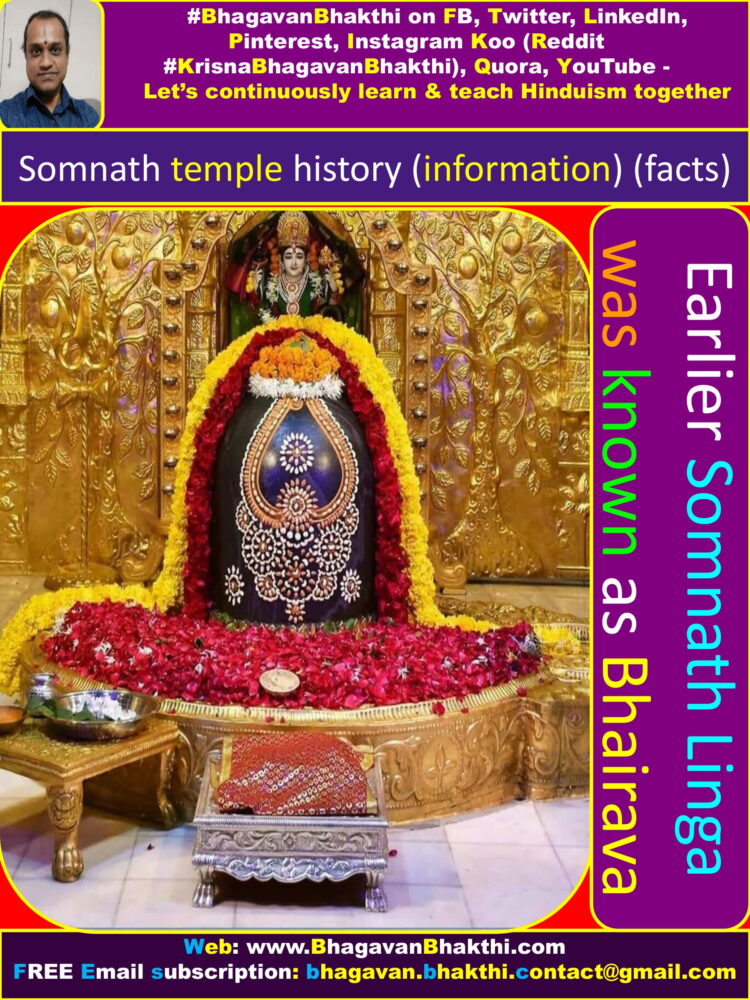
‘Unfortunately, people of Kali Yuga under the influence of all pervading ignorance would fail to recognize the importance of holy places.
‘Such people would try to demean the value of holy places and make fun of those people who go on pilgrimages.’
‘Being blinded by their superficial intelligence, they would try to find faults with rituals and religion.’
‘Such would be the condition of the mortals in Kali Yuga, that they would criticize everything that is religious and spiritual in nature.’
‘How can one expect from these unfortunate people of Kali Yuga to understand the significance of Prabhas (Prabhasa) Kshetra and which is revered even by me?’
Parvati Devi, who had been listening to the tale with rapt attention, became even more curious to know about Prabhas (Prabhasa) Kshetra.
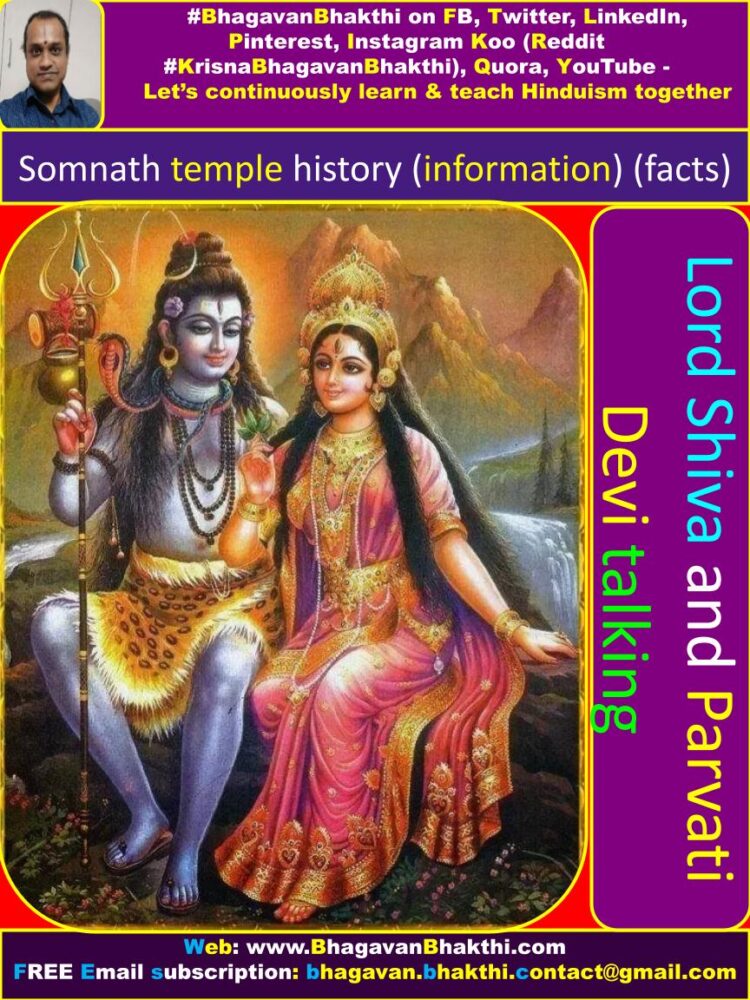
So, Parvati Devi requested Lord Shiva to shed more light on the other important aspects of this sacrosanct place.
Lord Shiva, continuing with his description of Prabhas (Prabhasa) Kshetra, said:
‘This sacrosanct place has temples of three Devatas (Demigods) on it’s three sides.’
‘To its east is situated a grand temple of Sri Surya Narayana,
While there is a magnificent temple of Sri Madhava to it’s west.
In the same way there is a beautiful temple of goddess Bhavani Devi to the north of Prabhas (Prabhasa) Kshetra and
Towards it’s south lies the ocean.’
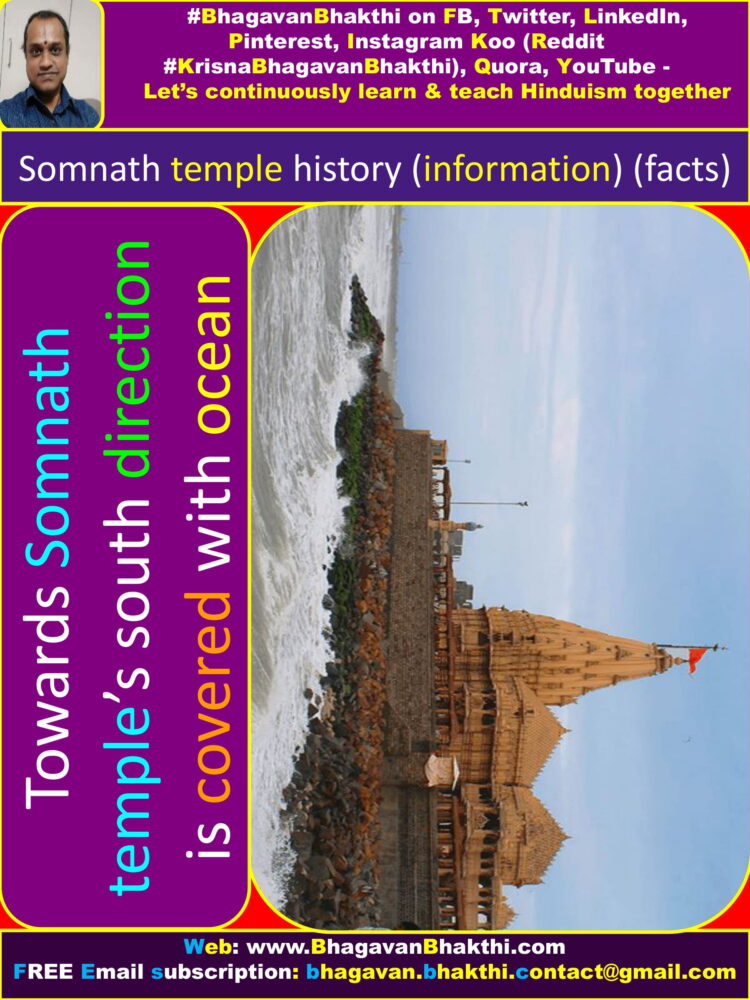
‘This holy place is spread in the area of five yojanas and is divided in three major areas:
Maheshwara, Vaishnava and Brahma
There are about one crore temples related with different Devatas (Demigods) in Vaishnava and Brahma Kshetras, while Maheshwar (Maheshwara) Kshetra contains one and half crore temples.
As the name implies, each area has been named after one God forming the Trinity.
Anybody who has the good fortune of living in the central part of Prabhas (Prabhasa) Kshetra, becomes absolved of all his sins even if he has committed most abhorrent sins.
The significance of this holy place can be understood by the fact that a man born their does not take a second birth and attains salvation.
One whom scholars of the Vedas call ‘Kalagni Rudra‘ (कालाग्नि रुद्र / ಕಾಲಾಗ್ನಿ ರುದ್ರ / kālāgni rudra) is famously known as Bhairava in Prabhas (Prabhasa) Kshetra.
About Somnath (Somanatha) Linga
Emphasizing on the significance of Someshwar (Someshwara) Linga and its deep association with the Vedas, Lord Shiva told Parvati Devi:
‘The divine Someshwar (Someshwara) Linga (Somnath Linga) exists since time immemorial and will remain for eternity.
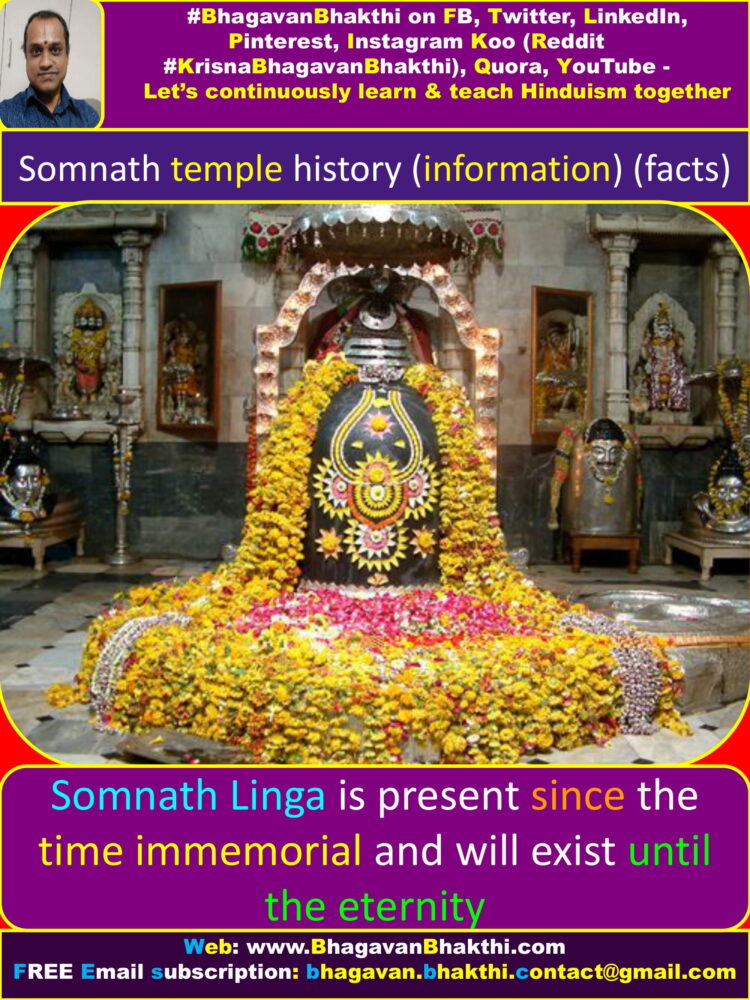
This revelation descended on me, while I was engrossed in a deep state of meditation.
Someshwar (Someshwara) Linga has deep association with the Vedas and it enhances their sanctity by establishing itself in each of them at different periods of time during the day.
During morning time, Someshwar (Someshwara) Linga establishes itself in the Rigveda,
During noon in the Yajurveda,
During afternoon in the Samaveda and
During evening time it establishes itself in Atharvana (Atharva) Veda.
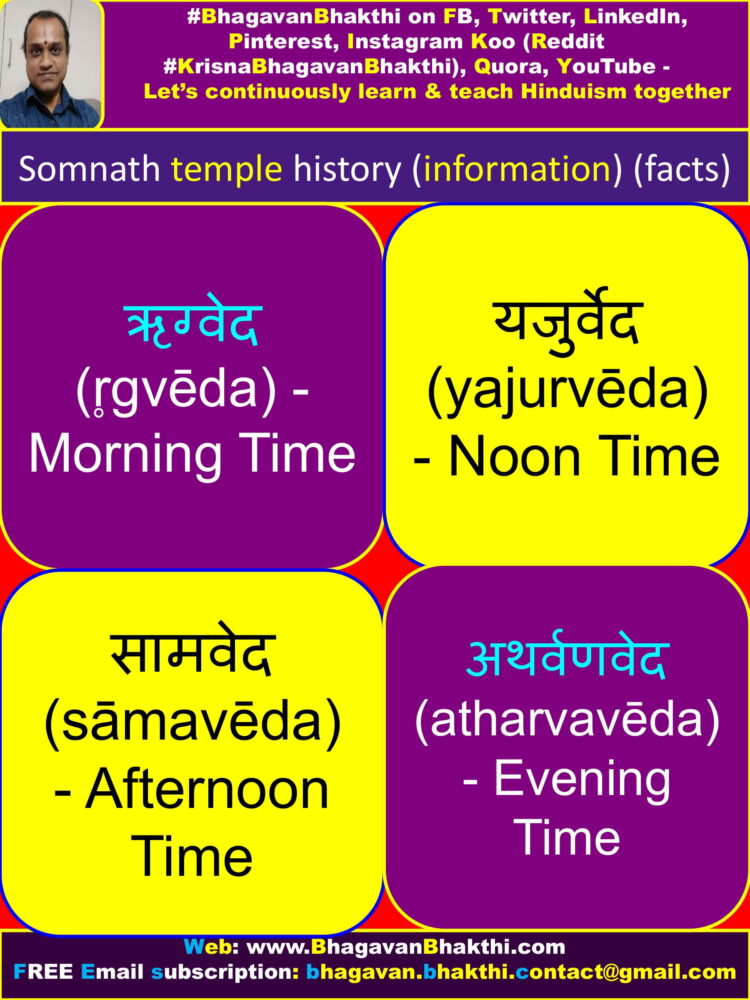
Different names of Somnath (Somanatha) Jyotir Linga is as given below:
Parvati Devi curiously asked Lord Shiva about the reason why Somnath (Somanatha) was known by so many different names.
Lord Shiva said:
‘Since the time this divine Linga first manifested itself, very few blessed souls had the knowledge of it’s existence.
‘‘Sri Brahma Deva has a life span of one Kalpa at the end of which even he ceases to exist giving way to his successor – a new Sri Brahma Deva.’‘
In the same manner this divine Linga acquires a new name at the end of each kalpa.
‘‘The present kalpa is seventh in order as six kalpas have already passed.
‘‘The name of the present Sri Brahma Deva is Shatananda and this divine Linga is presently famous by the name of Somnath (Somanatha).’‘
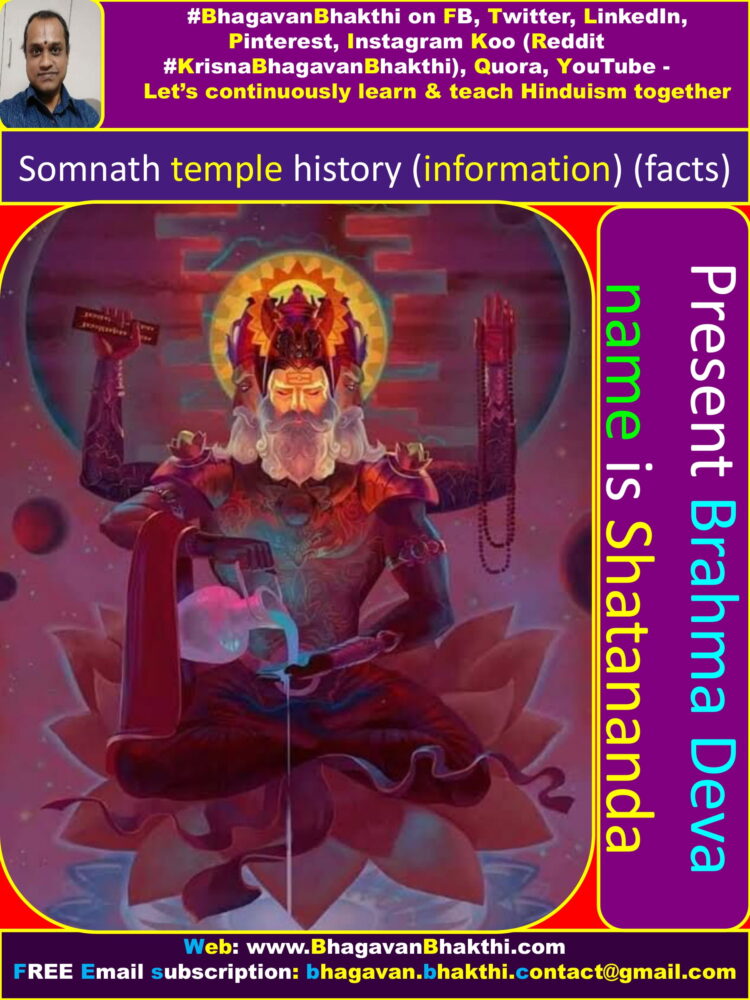
Similarly, it was famous as Mrityunjaya during the time of Sri Brahma Deva named Virinchi.
‘‘During second kalpa, this Linga was famous as Kalagnirudra and the name of Sri Brahma Deva was Padmabhu.’‘
The third kalpa had Swayambhu as Sri Brahma Deva and the Linga was famous as Amritesha.
‘‘The name of the fourth Sri Brahma Deva was Parmeshthi in fourth kalpa and the Linga was famous as Annamaya.’‘
In the same way, the name of the fifth and sixth Sri Brahma Devas were Surajyeshtha and Hemagarbha respectively and
the names of the Linga during their periods were Kritiwasa and Bhairava Natha respectively.’
Lord Shiva also revealed to Parvati Devi that the next kalpa – eighth in order would have Chaturmukha as Sri Brahma Deva and the divine Linga would be known as PranaNatha.
Goddess Parvati Devi then asked Lord Shiva about the exact location of the Linga in Prabhas (Prabhasa) Kshetra (Somnath Jyotirlinga place).
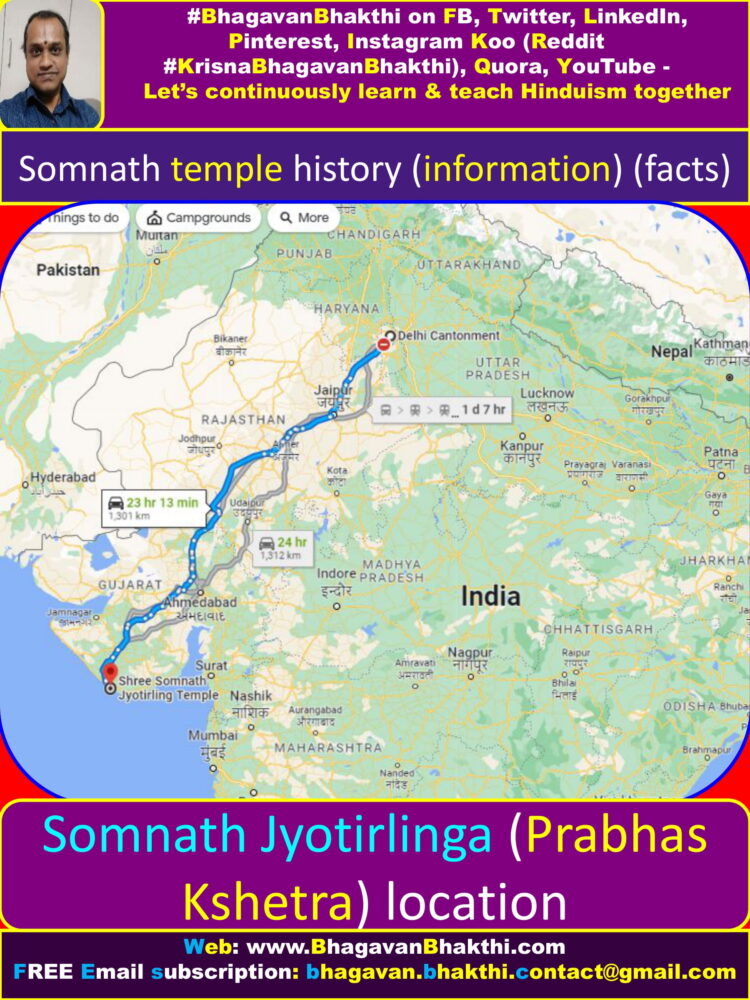
Lord Shiva told her that the sacrosanct place of Prabhas (Prabhasa) Kshetra was situated between the plains of two rivers Vajrini and Nyankumati.
Lord Shiva also told her that the eternal Linga was not very far from the sea coast.
Dwelling at length about the good fortunes of those living in Prabhas (Prabhasa) Kshetra, Lord Shiva told Parvati Devi:
‘Anybody who does not abandon this holy place despite his hardships and troubles is certain to attain to my abode.’
‘One who has the good fortune of dying at Prabhas (Prabhasa) Kshetra, attains salvation (Moksha).’
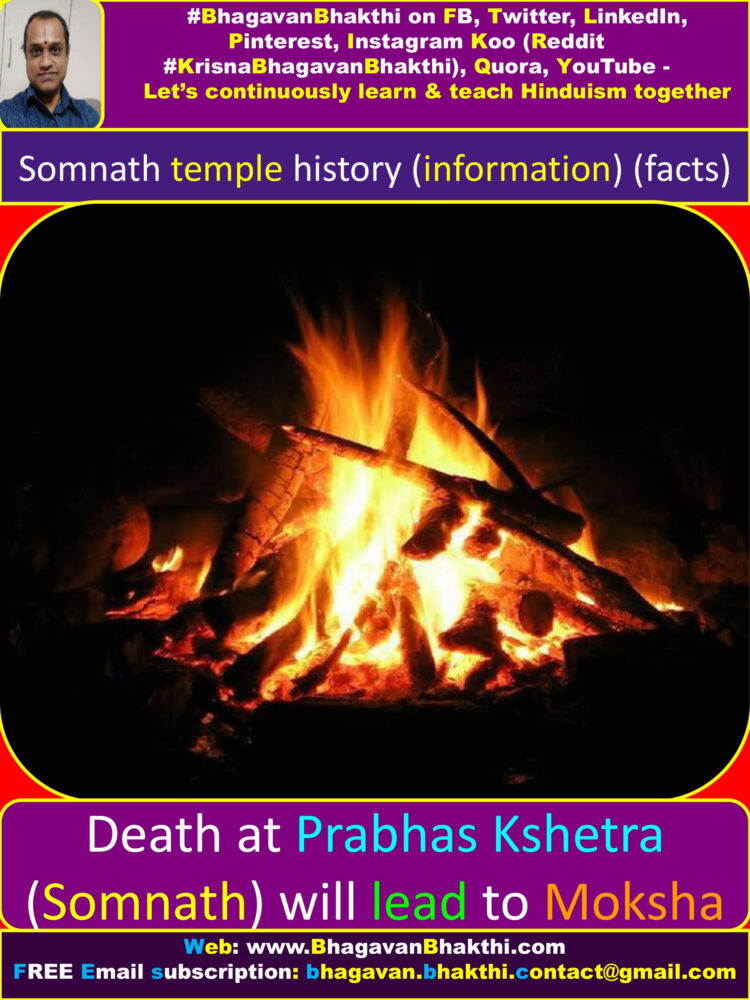
‘There will be prevalence of sins in Kaliyuga.’
‘As a result of this people would experience all sorts of hurdles and problems in their lives.’
‘To minimize their sorrows and to lessen their miseries, I have personally instructed Ganesha not to abandon this place even for a moment.’
‘Of all the Lingas present on the earth, Somnath (Somanatha) is specially dear to me.’
Siddheshwar (Siddheshwar) Linga and Siddh (Siddha) Linga
Describing the reason why this sacrosanct place was named Prabhas (Prabhasa) Kshetra, Lord Shiva told Parvati Devi:
‘I (Lord Shiva) dwell in the entire area stretching between the ocean in the south and river Kaureshwari.’
‘Being situated at the western coast, this entire area is radiated by Surya’s light for a relatively longer period of time and hence it has been named ‘Prabhas (Prabhasa)‘ meaning luster.’
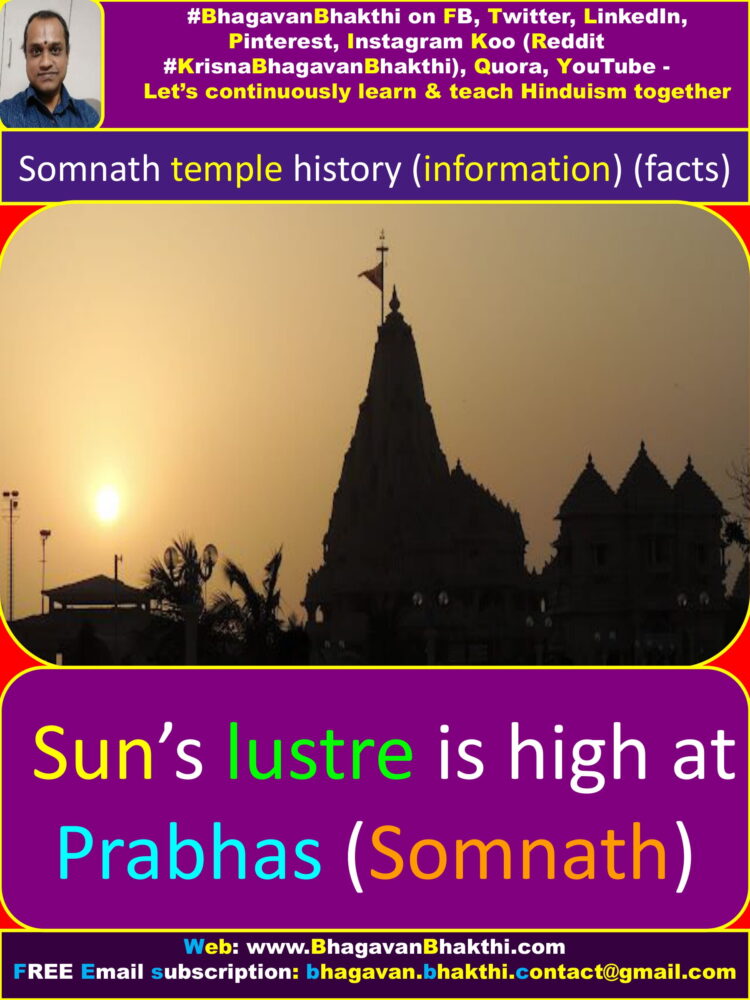
‘This is the reason why there is situated a grand temple of Sri Surya Deva in Prabhas (Prabhasa) Kshetra.’
‘Not far from this Sri Surya Deva temple is situated a magnificent temple of Sri Siddheshwar (Siddheshwara), which was famously known as Sri Yaigishavyeshwar (Yaigishavyeshwar) in ancient times.’
Lord Shiva then went on to describe why Sri Siddheshwar (Siddheshwara) was called Sri Yaigishavyeshwar (Yaigishavyeshwar) during ancient times:
‘There lived a sage named Jaigishavya in previous Kalpa.’
‘He used to daily worship a Lord Shiva Linga named Mahodaya, which had manifested on its own.’
‘Keeping in view Lord Shiva’s fondness for ashes, he used to smear it on his body hoping to please his deity.’
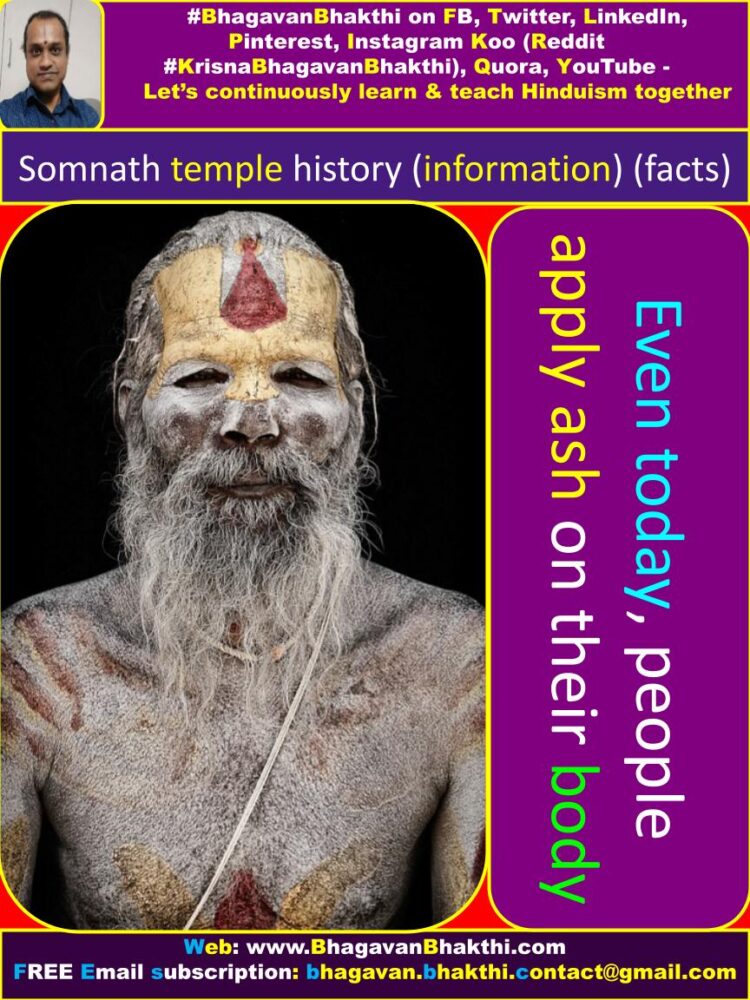
‘Not only this. he even slept on ashes.’
‘He thus led an extremely austere life. At last he was able to please Lord Mahodaya by his devotion.’
‘When Lord Mahodaya appeared before him and expressed his willingness to fulfill anything he wished, but Jaigishavya wanted nothing but total devotion in his deity (Mahodaya).’
Lord Mahodaya blessed him with immortality and said:
‘There would be nobody as powerful as you.’
Your feats achieved in spiritual things will be unmatched and you would become famous as ‘Yogacharya‘ or teacher of Yoga.’
‘One who regularly worships this particular Linga which you have been worshipping with such deep devotion till now is certain to get absolved of all his sins.’
Having blessed Yaigishavya thus, Lord Mahodaya disappeared from his sight.
After this incident, Mahodaya Linga also came to be known as Yaigishavyeshwar (Yaigishavyeshwara).
In course of time, when the Kaliyuga of that Kalpa arrived, some sages named ‘Balkhilayasa‘ had gone to the same place and worshipped Lord Mahodaya.
Similarly, many more sages went there and attained ‘siddhi‘ or accomplishment.

This is how this Linga came to be known as ‘Siddheshwar (Siddheshwar)‘ (the Lord of all accomplishments).
There are many holy places in the vicinity like Siddha Linga, which was installed by Lord Surya.
Anybody who worships this Linga on the auspicious day of trayodashi of the bright half of the Hindu month Chaitra, attains virtues similar to the accomplishment of ‘Pundareeka yagna‘.
Lord Chandra Deva eulogizes Lord Shiva as given below:
Parvati Devi asked Lord Shiva about the reason Chandra deva had to install a Shiva Linga at Prabhas (Prabhasa) Kshetra.
Lord Shiva replied that Daksha had got married twenty seven of his daughters to Lord Chandra Deva.
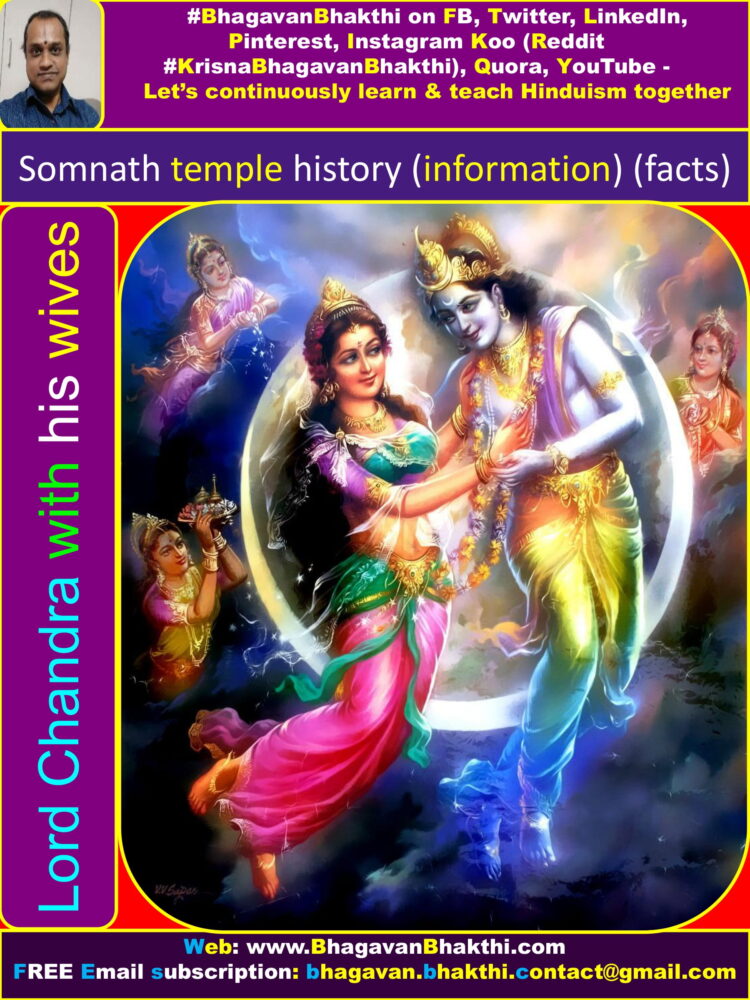
Lord Chandra Deva was very much attached to Rohini, who was one of them and neglected others.
When Daksha came to know about this, he cursed Lord Chandra Deva as the result of which he lost his luster and started waning day by day.
The worried Lord Chandra Deva did an austere penance for thousand of years to please Lord Shiva.
At last, Lord Shiva became pleased and appeared before him.
Subsequently, Lord Chandra Deva got a divine Shiva Linga installed by Lord Sri Brahma Deva and worshipped it for thousand of years.
Lord Shiva appeared once again and expressed his willingness to fulfill any wish Lord Chandra Deva expressed.
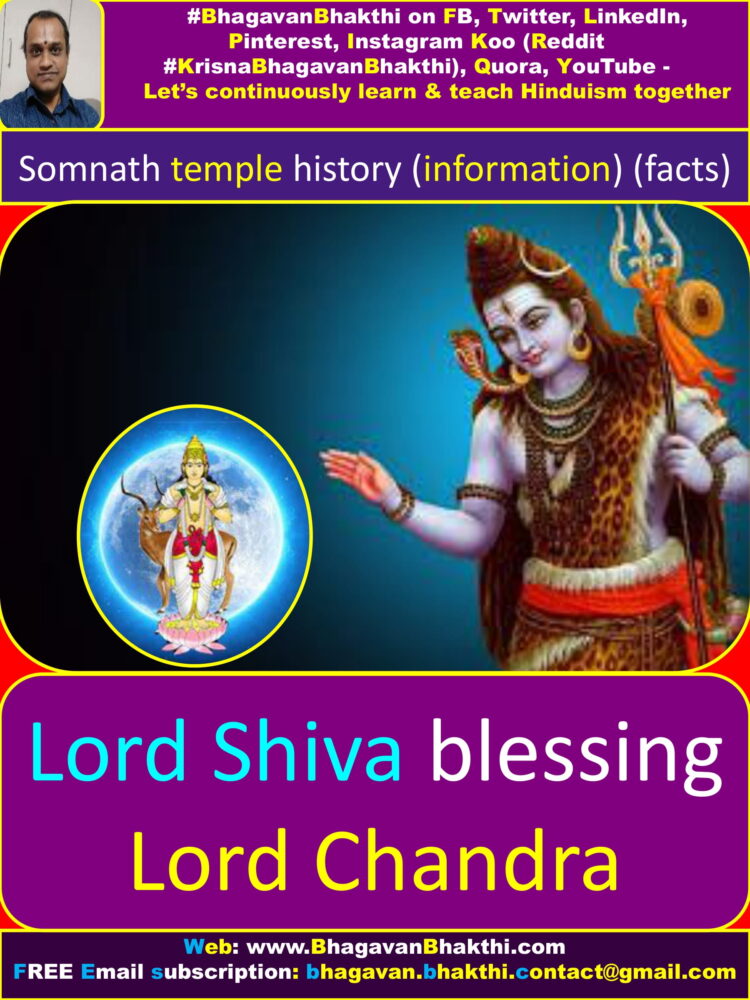
Lord Chandra Deva requested Lord Shiva to dwell in the very Shiva Linga he had been worshipping till then.
Lord Shiva revealed to him that there was no question of dwelling in the Shiva Linga, as he had never abandoned it in the first place.
Lord Chandra Deva had regained his luster on account of his arduous penance.
Lord Shiva blessed Lord Chandra and said as below:
‘Since you have regained your luster (Prabha) by dint of your austere penance, this holy place will become famous as ‘Prabhas (Prabhasa) Kshetra‘.
‘This Linga will be named upon you and become famous as Somnath (Somanatha) Linga.’
(Soma is one of the names of Lord Chandra Deva)
Having blessed Chandra Deva thus, Lord Shiva disappeared.
Later on Lord Chandra Deva instructed Vishwakarma to build a magnificent temple at the sight.

Vishwakarma also built a city nearby, so that all the priests who were supposed to supervise the rituals of worship could live there.
The significance of getting one’s head tonsured is as given below:
Dwelling on length about the significance of getting one’s head tonsured at holy places, Lord Shiva told to Parvati Devi:
‘A man should get his head tonsured whenever he gets an opportunity to visit a holy place, because hair are believed to contain all the sins he has committed.’
‘There is a holy place called ‘Padma Tirtha‘, not far from Somnath (Somanatha) temple.’
‘A devotee should first get his hair removed at Somnath (Somanatha) Tirtha and then immerse them at ‘Padma Tirtha‘.
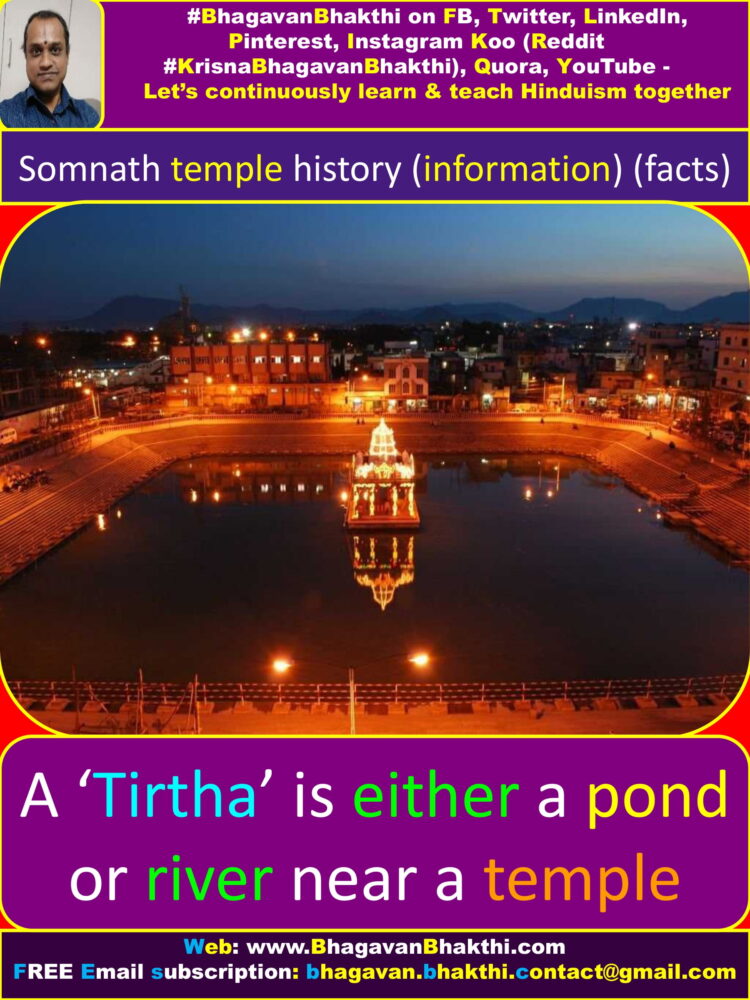
‘This way he becomes absolved of all his sins.’
‘Women should have a symbolical cut of their hair.’
‘It is necessary to perform the rituals of tarpana in the names of ancestors after the head tonsuring ceremony.’
‘According to the scriptures, an ocean is considered holy and nobody should bath at the holy water in an impure state.’
‘While bathing, a devotee should chant the following mantra:
Om namo Vishnu guptaaya Vishnu rupaaya namah | Saannidhye bhava devesha saagare lavanaambhasi ||
There are about five crore Shiva Lingas submerged in the ocean near Somnath (Somanatha).
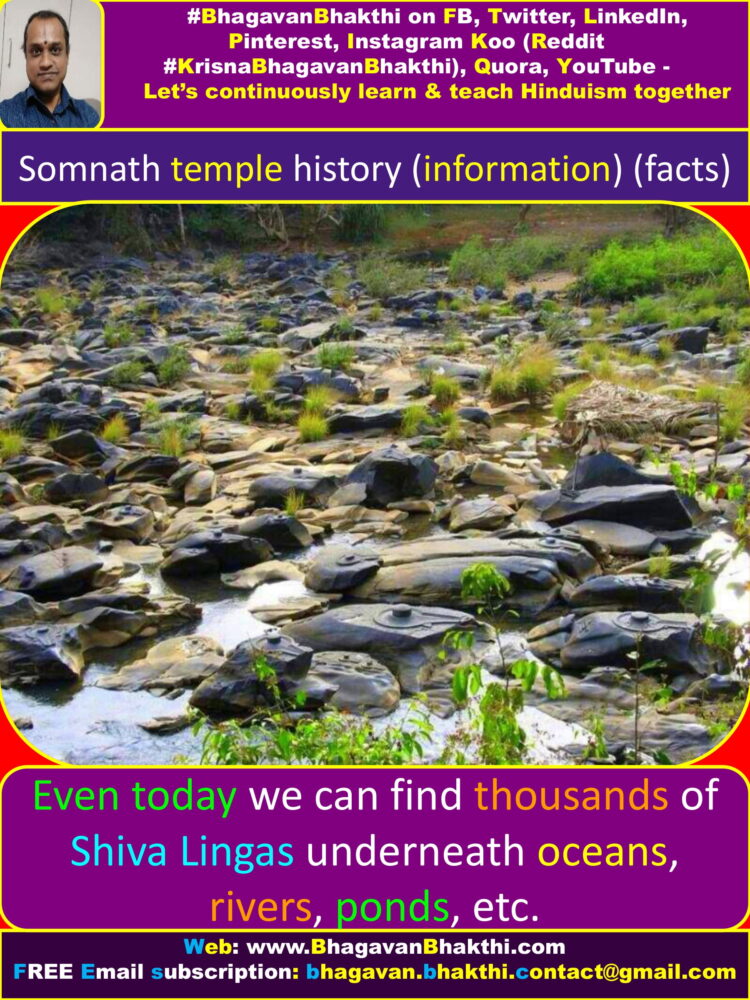
There are also other holy places situated nearby like Agni Kunda, Padma Sarovar (Sarovara) etc.
The emergence of Saraswati in Prabhas (Prabhasa) Kshetra
On being asked by Parvati Devi about the emergence of river Saraswati at Prabhas (Prabhasa) Kshetra, Lord Shiva narrated the following tale to her:
‘The holy Saraswati flowing in Prabhas (Prabhasa) Kshetra constitutes of five different streams as given below:
Harini, Vajrini, Nyanku, Kapila and Saraswati
Lord Sri Maha Vishnu, once instructed Saraswati Devi to carry ‘Badwanala‘ (Submarine fire) and dump it in the ocean near Prabhas (Prabhasa) Kshetra.
After taking permission from Sri Brahma Deva, his consort Goddess Sri Sarasvati Devi flew towards her destination.
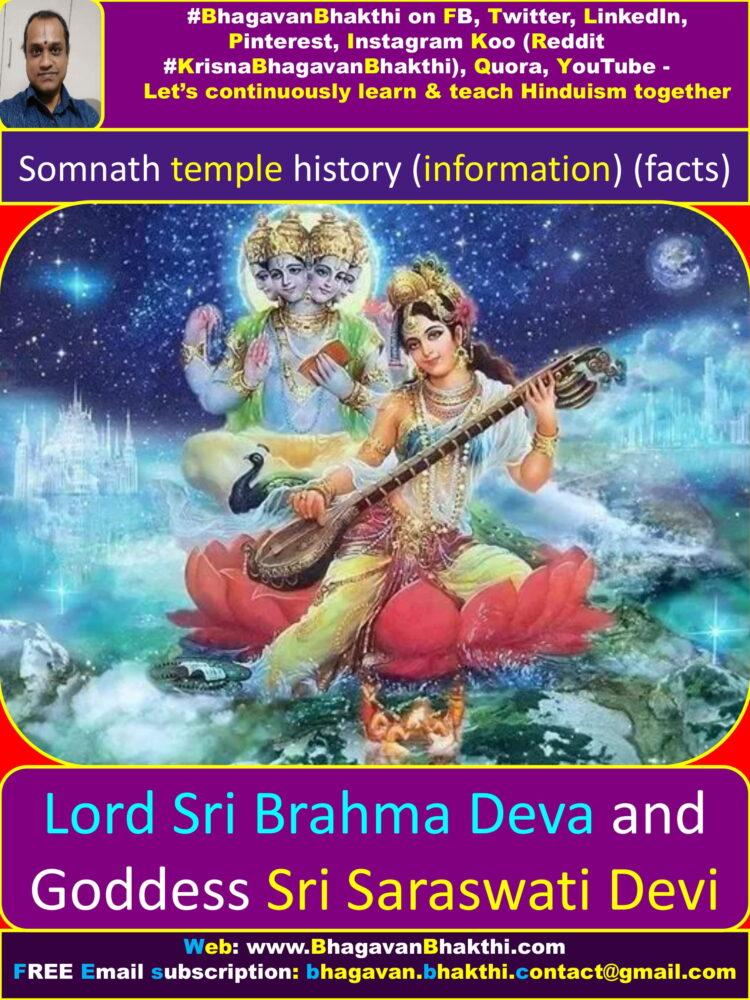
Ganga Devi became sad at her departure, so she asked her as to how could she have a glimpse of her now that she was going to such a distant place.
Goddess Sri Sarasvati Devi consoled Ganga Devi by saying that she would be able to see her whenever she looked eastwards.
The swift currents of Goddess Sri Sarasvati Devi penetrated the earth and reached Patala Loka carrying Badwanala along with her.
She continued to move beneath the ground towards her destination.
As she reached Prabhas (Prabhasa) Kshetra, four learned sages, who were well versed in Vedas arrived there and invoked Goddess Sri Sarasvati Devi to give them the privilege of separate bath by dividing herself in four different streams.
The names of these sages were:
Hiranya, Vajra, Nyanku and Kapila
While Saraswati Devi was about to comply with their request, suddenly Samudra arrived there and he too expressed the same wish.
Thus Saraswati divided herself into five different streams:
Harini, Vajrini, Nyanku, Kapila and Saraswati
Eventually, when Goddess Sri Sarasvati Devi reached near the ocean, Badwanala whom she was carrying was surprised to see the high tides rising in the ocean.
He thought that the Samudra was frightened of his fury so he asked Goddess Sri Sarasvati Devi:
Why is the ocean scarred of me?
Goddess Sri Sarasvati Devi inflated his ego by saying that who would not be scarred of him.
Badwanala was pleased and wanted to grant her a boon.
Goddess Sri Sarasvati Devi remembered Lord Sri Vishnu, who instantly gave his divine appearance in her heart.
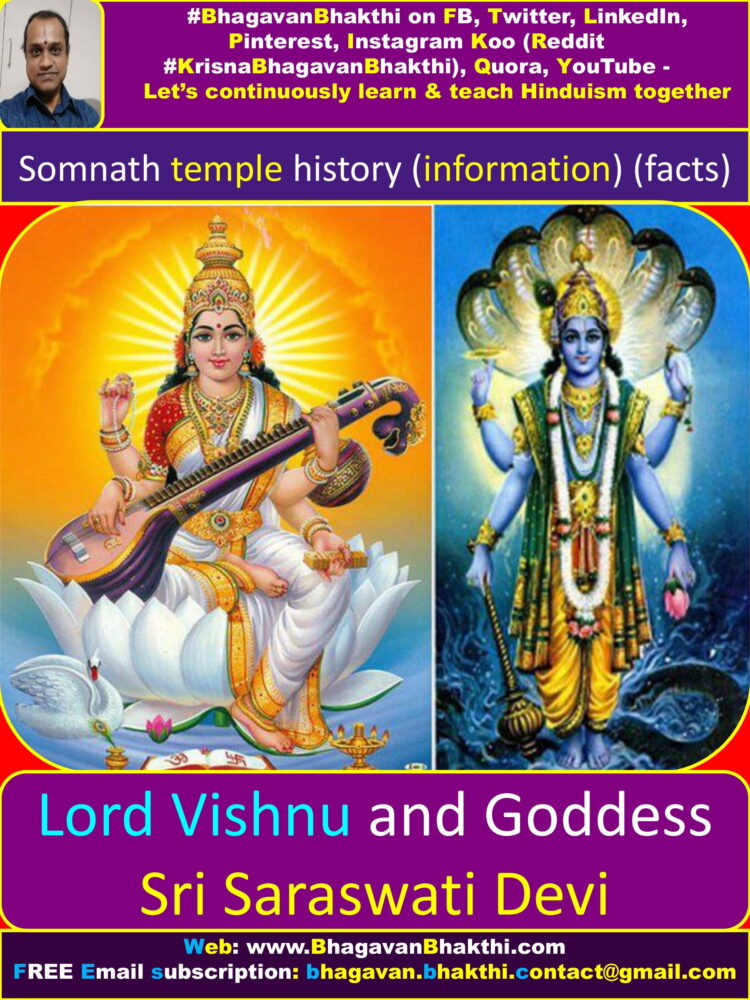
She narrated the whole story and sought his advise.
Vishnu Sri Vishnu advised her to ask Badwanala to make his appearance small like the eye of a needle.
Goddess Sri Sarasvati Devi, following the advise of Lord Sri Vishnu asked Badwanala to become small like a needle and keep sucking the ocean.
Subsequently, Goddess Sri Sarasvati Devi summoned Samudra (Ocean) and told him to accept Badwanala to which he agreed.
This way Samudra devoured Badwanala, who continues to suck the water of the ocean even today as per the instructions given by Goddess Sri Sarasvati Devi.
It is believed that tides are nothing but the manifestation of Badwanala’s exhalations.
This was how Goddess Sri Sarasvati Devi emerged in Prabhas (Prabhasa) Kshetra (It is called as Prabhas Patan today).
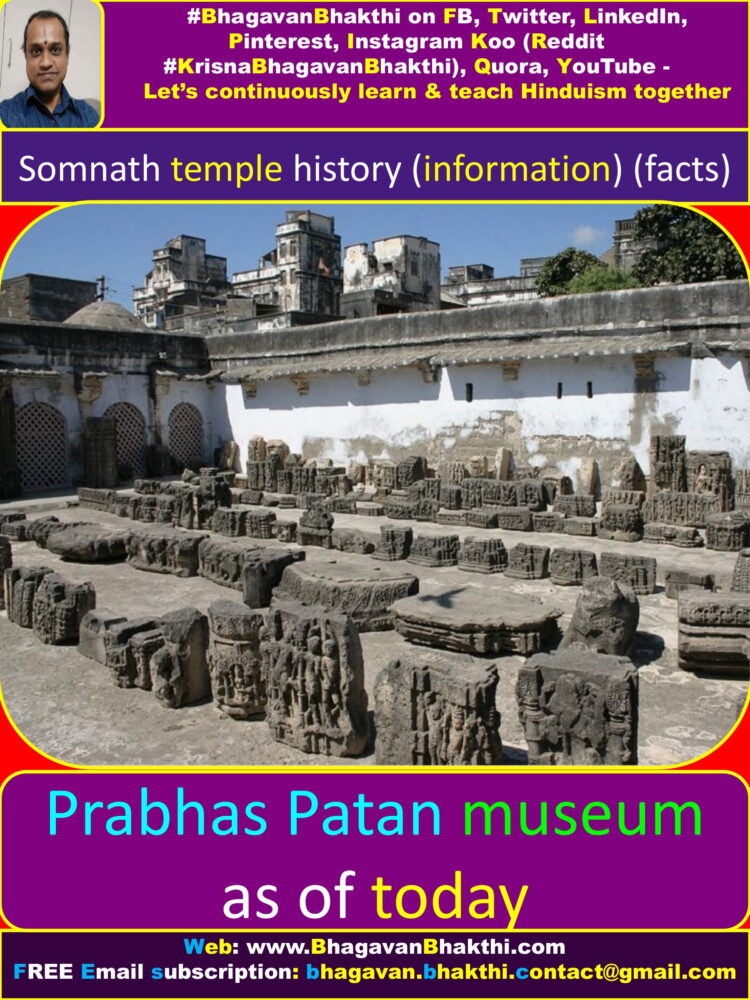
Prabhas (Prabhasa) Kshetra – the abode of trinity Goddesses
Lord Shiva revealed to Goddesses Sri Parvati Devi that Prabhas (Prabhasa) Kshetra boasted of possessing many more Shiva Lingas apart from the famous Somnath (Somanatha) Shiva Linga.
He also gave names of some of the prominent Shiva Lingas situated over there and said:
‘To the North-East of Somanath temple is situated a grand temple of Lord Sarveshvara Deva, who is also famously known as Siddheshwar (Siddheshwara).’
‘The reason behind this is that Shiva Linga over there had been installed by the ‘siddhas‘ (accomplished ones) in ancient times.’
‘People who are desirous of acquiring siddhis throng this holy place and engage themselves in austere penance.’
‘To the east of Siddheshwara temple is situated one more temple called Kapileshwar (Kapileshwara).’
‘It has been named after sage Kapila (He is an avatar of Lord Vishnu), who had installed the Shiva Linga over there.’
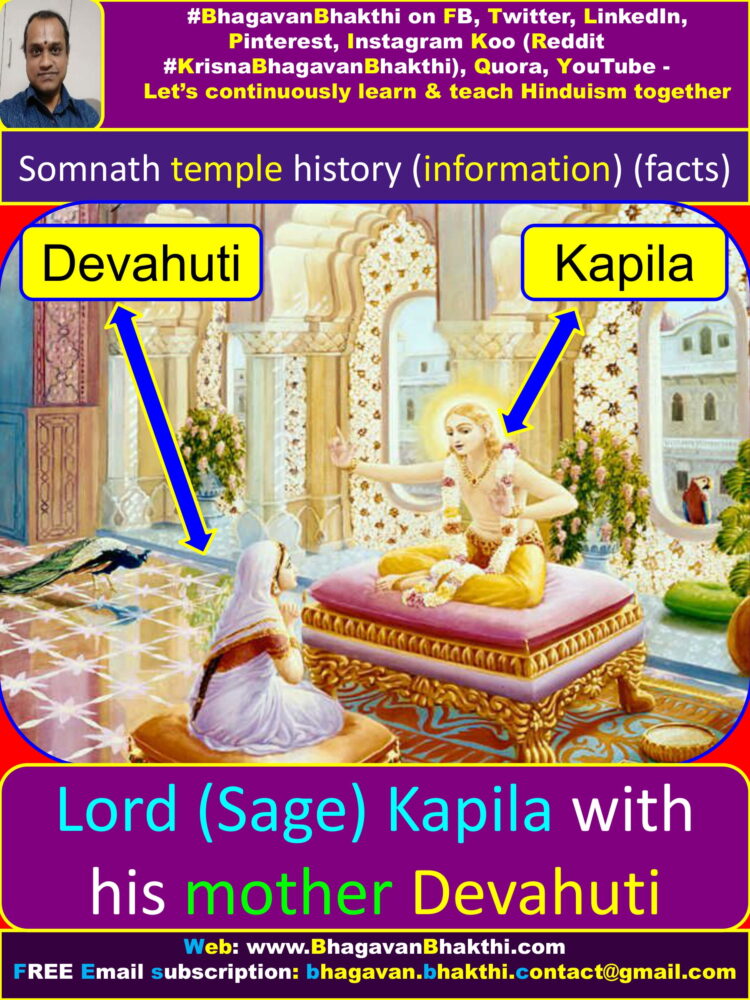
‘A Shiva Linga named Gandharveshwar (Gandharveshwara) is also situated nearby. This particular Shiva Linga had been installed by a Gandharva named Dhanavahana.’
‘To the east of Gandharveshwara temple is situated Vimaleshwar (Vimaleshwara) temple.’
It is believed that anybody suffering from tuberculosis gets cured after he worships in that temple.’
‘Dhanadeshwar (Dhanadeshwara’ Linga was installed by Kubera, who was bestowed with the Lordship of wealth on account of his austere penance.’
Lord Shiva told Parvati Devi that there were also temples of three Goddesses in Prabhas (Prabhasa) Kshetra apart from Lord Shiva temples. These three goddesses were:
Mangala, Vishalakshi and Chatawara
All these are representing the three types of power, that is, will power, power of action and power of knowledge.
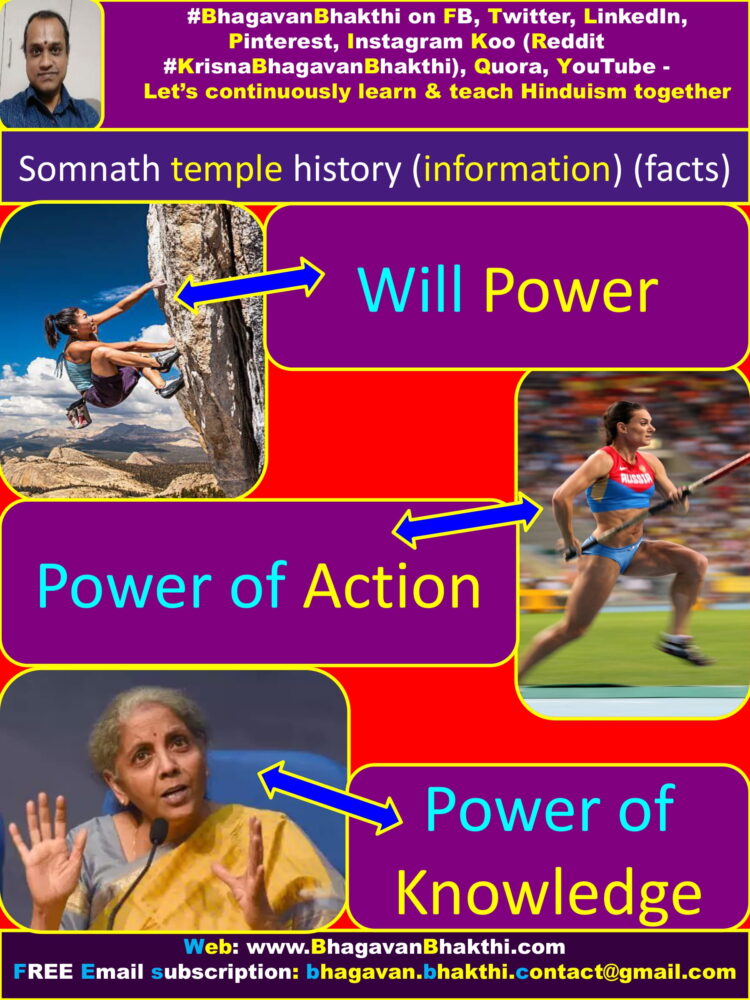
Lord Shiva said:
‘The pilgrimage to Prabhas (Prabhasa) Kshetra is believed to be incomplete until and unless these three goddesses have been worshipped.’
‘Goddess Mangala represents the power of Lord Brahma (Brahma shakti),’
‘While Goddess Vishalakshi that of Lord Vishnu, and’
‘Goddess Chatawara represents my (Lord Shiva) power.’
Goddess Mangala holds the privilege of getting worshipped first.
During ancient times, Lord Chandra did an austere penance for thousand of years and all the Devatas (Demigods) including Lord Sri Brahma Deva had gone there to witness his amazing feat.
At that time Goddess Mangala had blessed them and this was how she got her name.’
Lord Shiva then went on to describe how Goddess Vishalakshi got her name as below:
‘A fierce battle had taken place between the Devatas (Demigods) and demons during Chakashusa manvantara.’
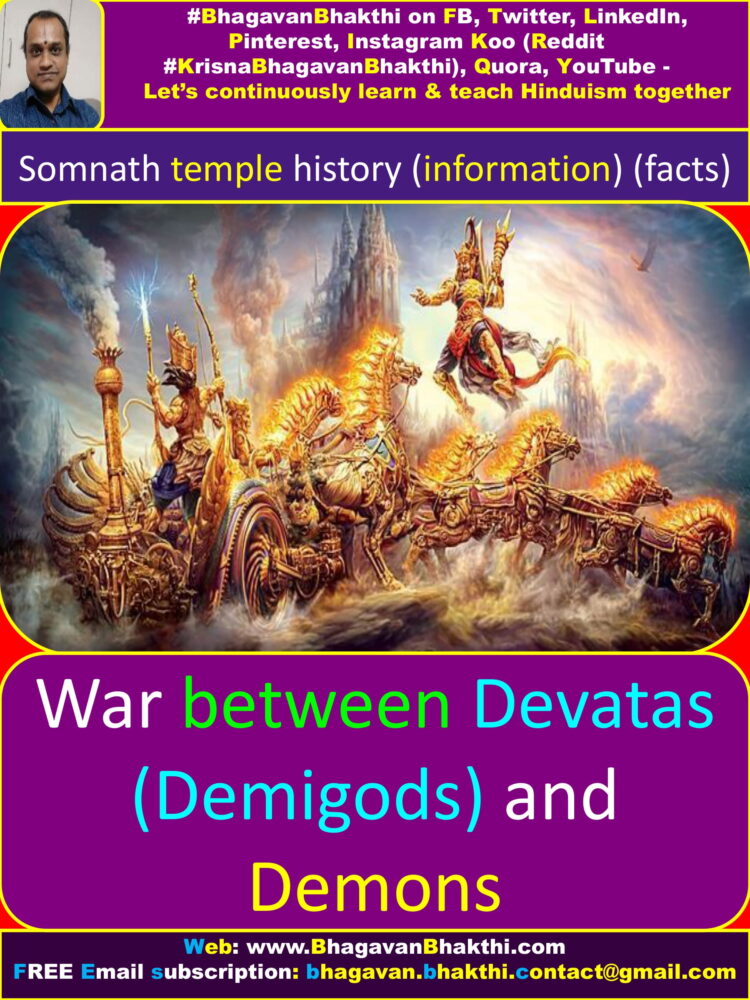
‘Lord Sri Vishnu fought along with the Devatas (Demigods) and helped them in defeating the demons.’
‘Demons fled towards the south, but were chased by the Devatas (Demigods).’
‘Realizing that it was not easy to annihilate the demons, Lord Sri Vishnu remembered Goddess Mahamaya and sought her help.’
‘Mahamaya appeared instantly and looked at Lord Sri Vishnu with her large eyes.’
‘This is how she got her name Vishalakshi.’
(Vishalakshi – Vishala = large / huge and akshi = eyes).
In the present Kalpa she is also known as Lalitoma.
To the south of Vishalakshi temple is situated the temple of Goddess Chatawarapriya.
Goddess Chatawarapriya is the saviour of people living in that area.
Anybody who worships her on the auspicious day of Mahanavami (During Navaratri time) with appropriate rituals is blessed.
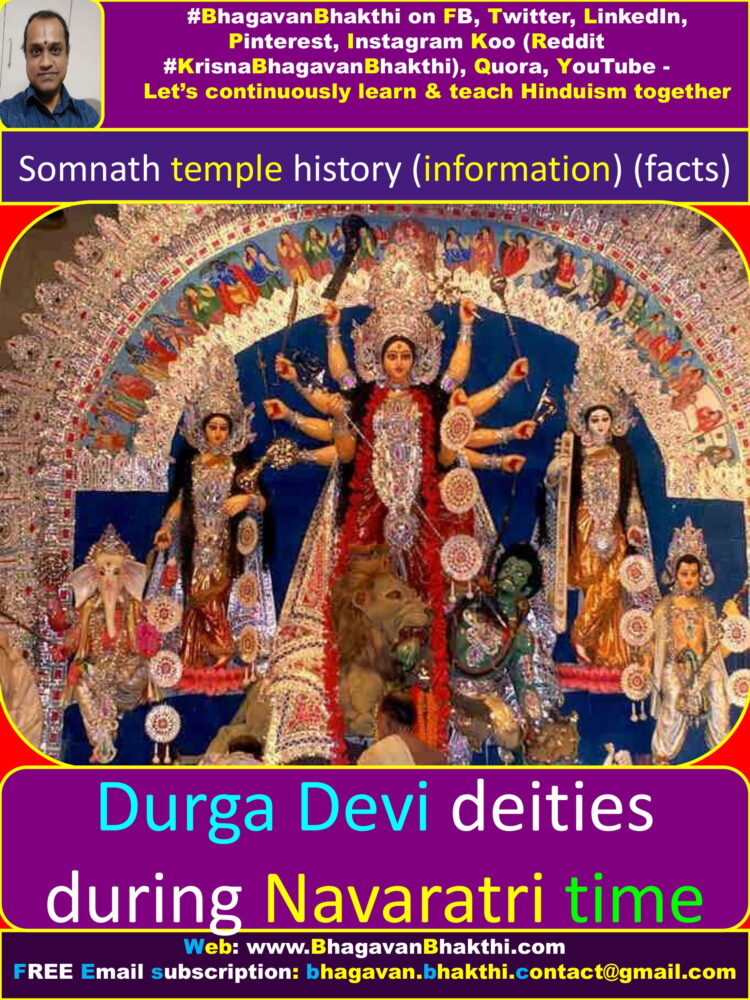
PS: He we should always remember that, Lord Sri Vishnu doesn’t need any ones support or help or anything.
Here Lord Sri Vishnu want to show the greatness of all the Devatas (Demigods) and thus acts as if he is taking help and support from other Devatas (Demigods).
This is called as the ‘Maya‘ (Illusion) of Lord Sri Vishnu.
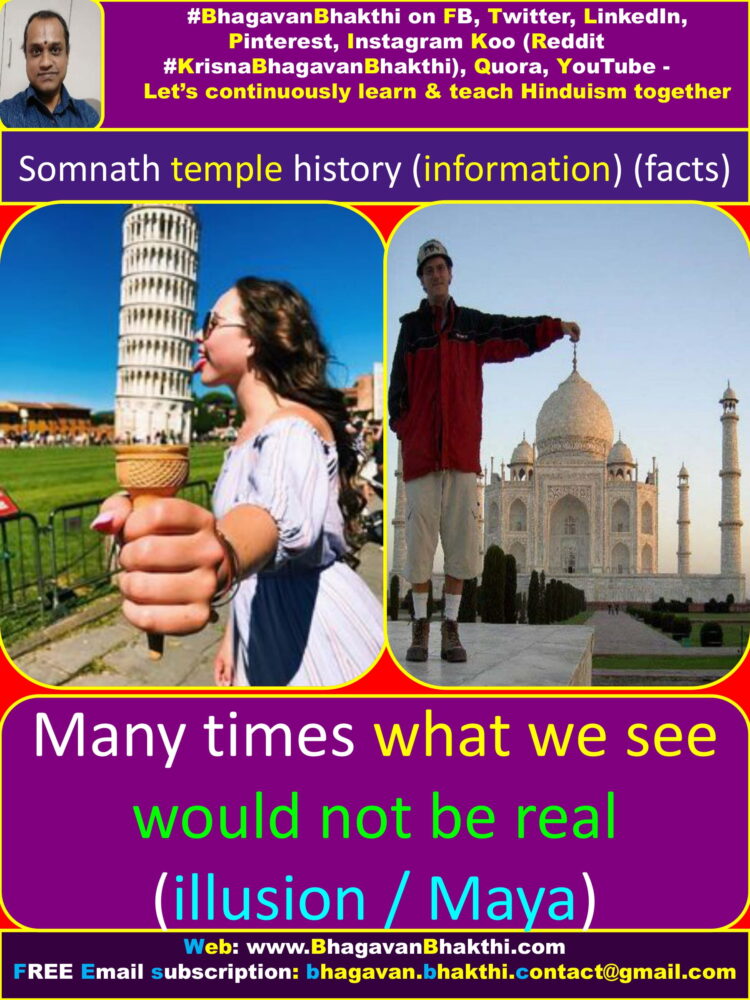
More information will be added to this on regular basis.
Please this post and other posts of this website / blog to get the updated information.
To watch videos on #Hinduism #Sanskrit language, SUBSCRIBE to my YouTube channel from this below link:
#BhagavanBhakthi YouTube channel
To know bout ‘Pilgrimage places (Tirtha Kshetras) in India‘, please click the below link:
Pilgrimage places (Tirtha Kshetras) in India
Dear friends, if you need any clarifications about this post, kindly let me know, I will definitely try to answer all of them.
Also your one LIKE, one COMMENT, One Share, one SUBSCRIPTION is highly important.
This will help to know the quality of this content and also it will be helpful to know if any improvements is required for the content.
If you feel this content is useful to you and has helped you to improve your knowledge, kindly share this with your well-wishers.
Because “SHARING MEANS CARING”.
For receive FREE EMAIL SUBSCRIPTION about #BhagavanBhakthi, you can send an email to bhagavan.bhakthi.contact@gmail.com from your email ID.
NAMASTE!
SRI GURUBHYO NAMAHA
OM NAMO NARAYANAYA
Sri Krishnaarpanamastu
Thank you for valuable information.
Hare Krishna!
Chandan Yatra Das
http://www.holy-pilgrimages.com/